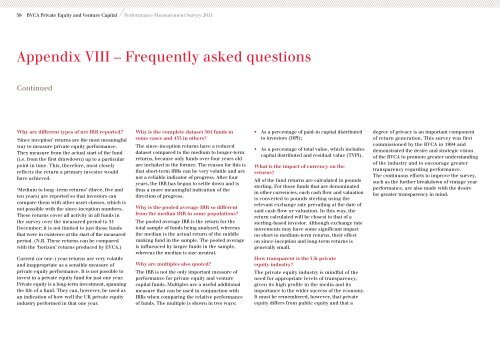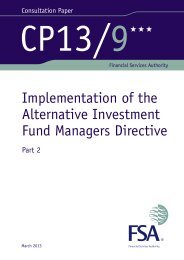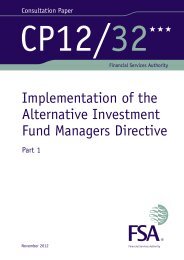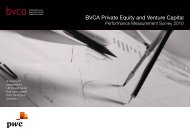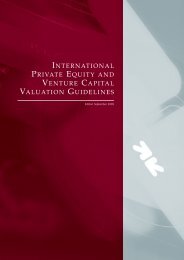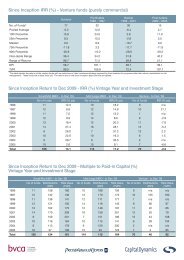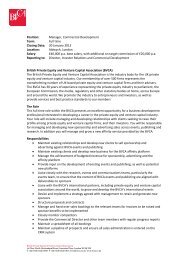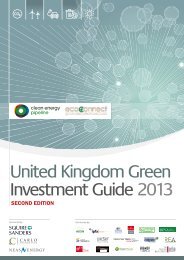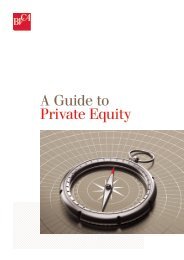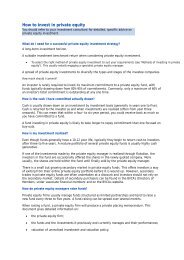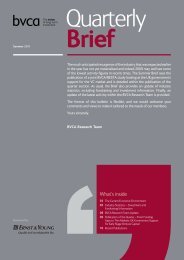BVCA Private Equity and Venture Capital ... - BVCA admin
BVCA Private Equity and Venture Capital ... - BVCA admin
BVCA Private Equity and Venture Capital ... - BVCA admin
Create successful ePaper yourself
Turn your PDF publications into a flip-book with our unique Google optimized e-Paper software.
58 <strong>BVCA</strong> <strong>Private</strong> <strong>Equity</strong> <strong>and</strong> <strong>Venture</strong> <strong>Capital</strong> Performance Measurement Survey 2011<br />
Appendix VIII – Frequently asked questions<br />
Continued<br />
Why are different types of net IRR reported?<br />
‘Since inception’ returns are the most meaningful<br />
way to measure private equity performance.<br />
They measure from the actual start of the fund<br />
(i.e. from the first drawdown) up to a particular<br />
point in time. This, therefore, most closely<br />
reflects the return a primary investor would<br />
have achieved.<br />
‘Medium to long -term returns’ (three, five <strong>and</strong><br />
ten years) are reported so that investors can<br />
compare them with other asset classes, which is<br />
not possible with the since-inception numbers.<br />
These returns cover all activity in all funds in<br />
the survey over the measured period to 31<br />
December; it is not limited to just those funds<br />
that were in existence at the start of the measured<br />
period. (N.B. These returns can be compared<br />
with the ‘horizon’ returns produced by EVCA.)<br />
Current (or one-) year returns are very volatile<br />
<strong>and</strong> inappropriate as a sensible measure of<br />
private equity performance. It is not possible to<br />
invest in a private equity fund for just one year.<br />
<strong>Private</strong> equity is a long-term investment, spanning<br />
the life of a fund. They can, however, be used as<br />
an indication of how well the UK private equity<br />
industry performed in that one year.<br />
Why is the complete dataset 501 funds in<br />
some cases <strong>and</strong> 433 in others?<br />
The since-inception returns have a reduced<br />
dataset compared to the medium to longer-term<br />
returns, because only funds over four years old<br />
are included in the former. The reason for this is<br />
that short-term IRRs can be very volatile <strong>and</strong> are<br />
not a reliable indicator of progress. After four<br />
years, the IRR has begun to settle down <strong>and</strong> is<br />
thus a more meaningful indication of the<br />
direction of progress.<br />
Why is the pooled average IRR so different<br />
from the median IRR in some populations?<br />
The pooled average IRR is the return for the<br />
total sample of funds being analysed, whereas<br />
the median is the actual return of the middle<br />
ranking fund in the sample. The pooled average<br />
is influenced by larger funds in the sample,<br />
whereas the median is size-neutral.<br />
Why are multiples also quoted?<br />
The IRR is not the only important measure of<br />
performance for private equity <strong>and</strong> venture<br />
capital funds. Multiples are a useful additional<br />
measure that can be used in conjunction with<br />
IRRs when comparing the relative performance<br />
of funds. The multiple is shown in two ways:<br />
• As a percentage of paid-in capital distributed<br />
to investors (DPI);<br />
• As a percentage of total value, which includes<br />
capital distributed <strong>and</strong> residual value (TVPI).<br />
What is the impact of currency on the<br />
returns?<br />
All of the fund returns are calculated in pounds<br />
sterling. For those funds that are denominated<br />
in other currencies, each cash flow <strong>and</strong> valuation<br />
is converted to pounds sterling using the<br />
relevant exchange rate prevailing at the date of<br />
said cash flow or valuation. In this way, the<br />
return calculated will be closest to that of a<br />
sterling-based investor. Although exchange rate<br />
movements may have some significant impact<br />
on short to medium-term returns, their effect<br />
on since-inception <strong>and</strong> long-term returns is<br />
generally small.<br />
How transparent is the UK private<br />
equity industry?<br />
The private equity industry is mindful of the<br />
need for appropriate levels of transparency,<br />
given its high profile in the media <strong>and</strong> its<br />
importance to the wider success of the economy.<br />
It must be remembered, however, that private<br />
equity differs from public equity <strong>and</strong> that a<br />
degree of privacy is an important component<br />
of return generation. This survey was first<br />
commissioned by the <strong>BVCA</strong> in 1994 <strong>and</strong><br />
demonstrated the desire <strong>and</strong> strategic vision<br />
of the <strong>BVCA</strong> to promote greater underst<strong>and</strong>ing<br />
of the industry <strong>and</strong> to encourage greater<br />
transparency regarding performance.<br />
The continuous efforts to improve the survey,<br />
such as the further breakdown of vintage year<br />
performance, are also made with the desire<br />
for greater transparency in mind.


